Sugu Site Group:
The structure of a bronze implement production center for the "country of Na," and its change over time, come to light.
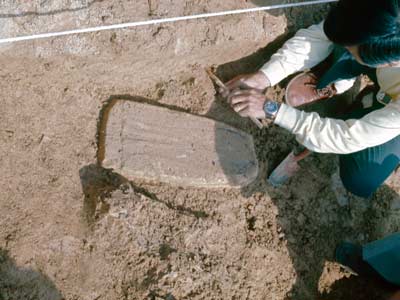
Discovery of a bronze halberd mold |
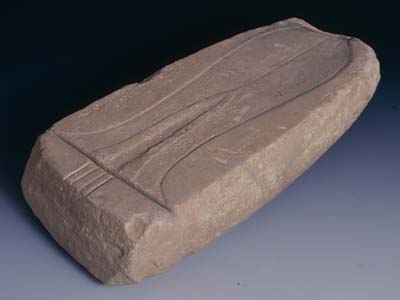
Bronze halberd mold |

Crucible stand |
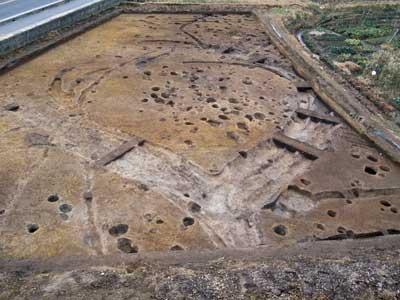
Bronze workshop group, Sakamoto precinct, Sugu Okamoto site Ditches surrounding an embedded pillar building are placed so they link together. Numerous artifacts related to bronze implement production, such as molds, were recovered centering on the ditches, confirming that bronze casting was conducted here. Ditches are thought to have been dug around such buildings to remove moisture from inside. Bronze workshop remains are distributed widely across the Sakamoto precinct, which is thought to have been the largest bronze workshop area in scale for the Yayoi period. A special structure encircled with a ditch has also been discovered at the Sugu Eida site, with numerous artifacts related to bronze manufacture recovered from the vicinity. |
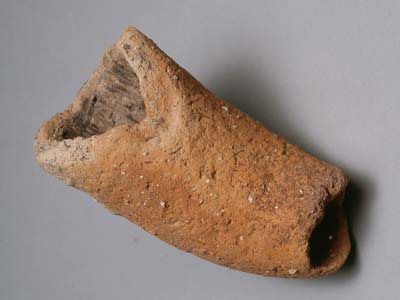
Bellows nozzle |

Crucible |
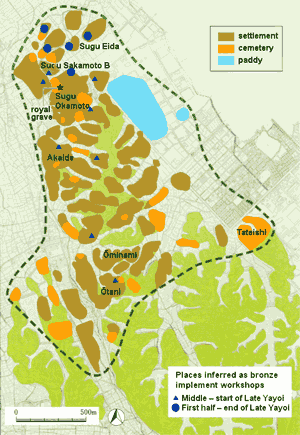
Extent of the Sugu site group Adapted from Hakkutsu sareta Nihon rettō 2010 [Excavations in the Japanese Archipelago, 2010] (Bunkachō [Agency for Cultural Affairs], ed., Asahi Shimbun Publications, 2010). | |
Sugu Site Group, Kasuga City, Fukuoka Prefecture
The royal center of Na
Sugu is a large-scale group of sites from the Middle to Late Yayoi periods (second century BCE - third century CE), located in and around the Kasuga hills of the southern Fukuoka plain. Settlements, cemeteries, rice paddies etc. are crowded together in an area stretching about 2 km north-south by 1 km east-west.
The Fukuoka plain is regarded as the former location of the gcountry of Nah noted in the Chinese chronicles, History of the Later Han and History of the Kingdom of Wei, and while it is dotted with Yayoi sites such as Itazuke which are famous nationwide, the Sugu group is the largest among these.
While thus noteworthy in scale, the region has also become noted for its concentrated finds of bronze implements of all types and the molds used in their manufacture, priceless artifacts showing cultural advancement. At the Sugu Okamoto site comprising the group's core, a jar burial with numerous grave goods, regarded as a royal grave of the country of Na, was discovered in 1899, and the area is accordingly regarded as the hub of Na.
Production and distribution of varieties of bronze implements
The number of molds for bronze implements discovered so far for the Sugu group and the Goryō site located to its northwest exceeds 150 items. This accounts for nearly half of the total found for Kyushu, and is a prominent proportion of the discoveries even when viewed nationwide. Bronze implements produced at this locale include many varieties, such as socketed spearheads, halberds, swords, small mirrors, and small bells, with the socketed spearheads in particular being manufactured in large amounts, and thought to have been distributed not only across the breadth of northern Kyushu, but also to Shikoku and the Chūgoku region, and the southern part of the Korean peninsula as well.
Workshops become concentrated
Bronze manufacturing is known to have begun in the first half of the Middle Yayoi period (second century BCE), and appears to have been conducted continually until the end of the Yayoi. From discoveries of molds it is inferred that in the Middle Yayoi bronze production was carried out in dispersed fashion in each village, but a trend for concentration in the vicinity of the Sugu Okamoto site can be seen in the Late Yayoi period.
At the Sugu Okamoto site's Sakamoto precinct, and at the Sugu Eida site, along with molds and many other artifacts related to bronze manufacture, features seen as those of a workshop where bronze casting was conducted have been found. Both instances consist of embedded-pillar buildings surrounded by ditches, with the latter inferred to be facilities for removing moisture from inside the workshop. (Hirata Sadayuki, Inoue Yoshinari)
Principal artifacts


|
Bronze sword mold |


|
(Item at left) (Item at right) |

Comma-shaped glass bead mold |

Diagram of mold for casting bronze socketed spearhead |
Adapted from Hakkutsu sareta Nihon rettō 2010 [Excavations in the Japanese Archipelago, 2010] (Bunkachō [Agency for Cultural Affairs], ed., Asahi Shimbun Publications, 2010).
